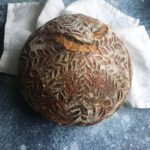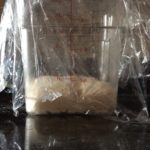
Country Loaf with Discard Sourdough Starter
A classic country loaf made with discard sourdough starter. Adapted from Tartine Bread.
Ingredients
- 450 g all-purpose and/or bread flour preferably King Arthur
- 50 g whole wheat flour or another whole grain flour (see notes)
- 50 g discard sourdough starter or less (see notes)
- 375 g cold spring water, divided or more (see notes)
- 10 g table salt or fine sea salt
Instructions
-
Pour 350 g cold spring water into a large wide mixing bowl, and add the discard starter, mixing to disperse the starter a bit.
-
Use your hands and/or a bowl scraper to mix in the all-purpose flour (or bread flour) and whole wheat flour until no dry bits of flour remain.
-
Allow the flour/water/starter mixture to rest for 25-30 minutes.
-
Add the salt and the remaining 25 g cold spring water to the bowl, working it in with your hands.
-
Transfer the dough to a large, clear, well-insulated container and cover the container with plastic wrap. Allow the dough to rest for 30 minutes.
-
After the 30-minute rest, complete three sets of stretch-and-folds, separated by 30 minutes. (In other words: if you do the first stretch-and-fold at minute zero, you'll do the second at thirty minutes, and the third at the end of the hour.)
-
Leave the dough in the covered container at warm room temperature (approx. 75 F) for 10-12 hours. You're looking for a 60% to 90% increase in volume. If you get home from work and the dough has not increased in volume, place the container in a turned-off oven with the pilot light on to speed the end of the bulk rise. For those who need a visual, here is my dough right after I transferred it to the bulk rise container--you'll see that it doesn't quite reach the 1 L mark; I generally wait until the dough has risen to about halfway between 1 L and 2 L before shaping.

-
Turn the dough out, pre-shape it, and allow it to rest for 15-30 minutes.
-
Shape the loaf as desired, and transfer it to a cloth-lined banneton that has been dusted with a mixture of white rice flour and all-purpose or bread flour.
-
Cover the banneton (I use a plastic shower cap), and leave it in the refrigerator overnight.
-
To bake the bread in a pre-heated dutch oven: In the morning, place your cast iron dutch oven (with lid) in the oven, and pre-heat the oven to 500 F.
When the oven has reached temperature, remove the banneton from the refrigerator, dust the top of the dough with white rice flour, and turn the loaf out onto a piece of baking parchment. Dust the loaf with flour (or not), and score as desired.
Using the parchment, carefully transfer the loaf to the pre-heated pot Replace the lid, and immediately place the pot in the oven.
Bake the loaf covered at 500 F for 20 minutes, then remove the lid, reduce the oven temperature to 450 F, and continue baking for another 25-35 minutes--until the crust is sufficiently dark for your taste.
-
To bake the bread with a cold start: In the morning, remove the banneton from the fridge, turn out the loaf onto a piece of parchment and score it as above. Place the scored loaf with parchment in an unheated dutch oven. Replace the lid, and transfer the pot to a cold oven.
Heat the oven to 500 F. Once the oven temperature has reached 500 F, bake the loaf in the covered pot for 20 minutes more. After the loaf has baked in the covered vessel for 20 minutes at 500 F, remove the lid, reduce the oven temperature to 450 F, and bake for 25-35 minutes uncovered.
-
Allow the loaf to fully cool on a wire rack before slicing.
Recipe Notes
- This recipe makes enough dough for one large (approximately 1.75 lb) loaf. To make a smaller loaf, just halve the quantities. To make two loaves, double the quantities. Keep in mind that, with this method, the amount of dough may affect the speed of the bulk rise, since a larger amount of dough will take longer to warm to room temperature.
- If your room temperature is moderately warm (74-75 F), the quantity of dough in this recipe, made with cold water, should rise sufficiently in 10-12 hours after you transfer the dough to the bulk rise container. However, if your kitchen is on the cool side (as mine has been lately), you'll need to (1) allow for additional time, (2) mix the dough with warmer water, or (3) raise the temperature of the dough, and speed the fermentation, by heating the room or placing the container in a turned-off oven with the pilot light on.
- The one thing you should NOT do is increase the amount of discard starter--I've found that inoculation with more than 10% discard starter results in overly sour flavor.
- On the flip side, if your kitchen is quite warm, and/or you are working with a very small quantity of dough and your room is moderately warm, you can further reduce the inoculation percentage. I've gone as low as 5%.
- Tartine Bread specifies all-purpose flour, but I've used bread flour or a mixture of all-purpose and bread flour with fine results, always King Arthur.
- While I think including some whole grain flour is what gives this loaf great flavor, it doesn't have to be whole wheat. I've used rye, spelt, and a mixture of whole wheat and spelt, all with great results.
- The recipe above specifies 375 g of water, total, or 75% hydration. However, you should feel free to experiment with increasing the hydration percentage. I've gone as high as 80%. Go with your instincts.
- I've included instructions both for baking in a preheated dutch oven (or combo cooker or similar vessel), or baking in a dutch oven with a "cold start." I've used both methods, and while there may be a *tiny* bit more oven spring when I bake my loaves in a preheated pot, the difference really is barely discernible.